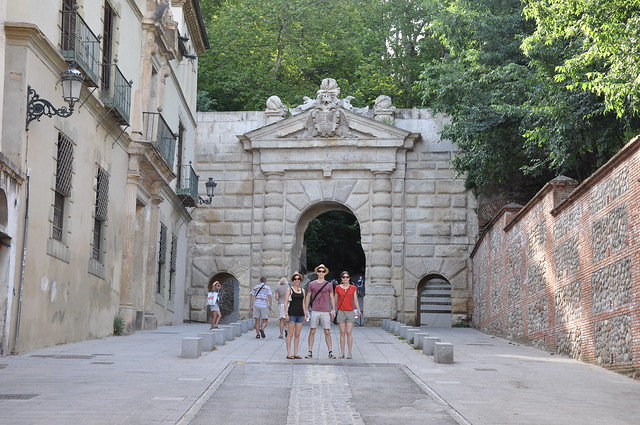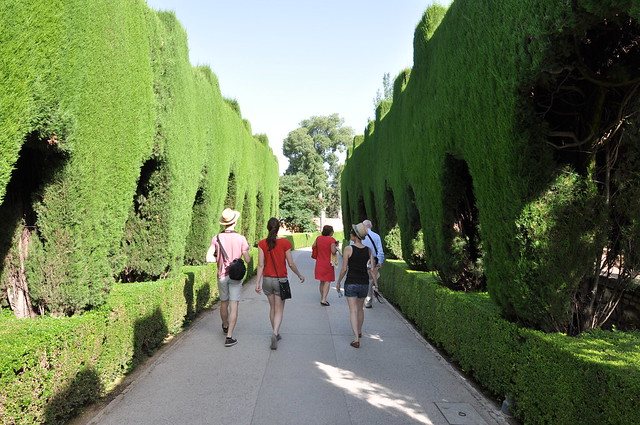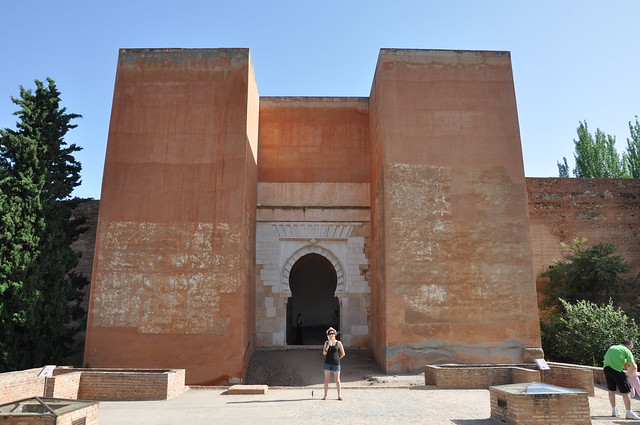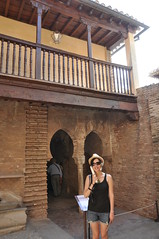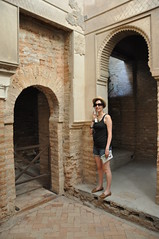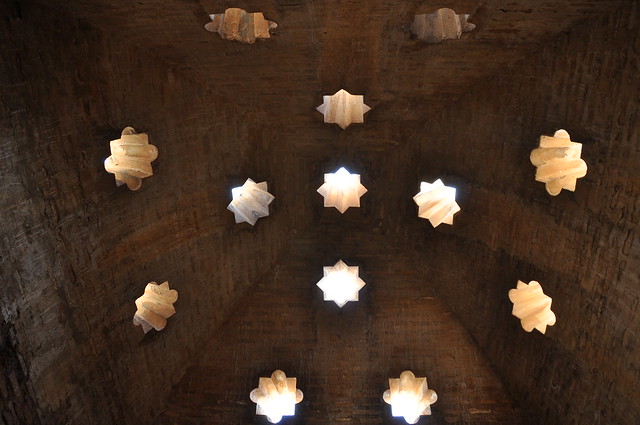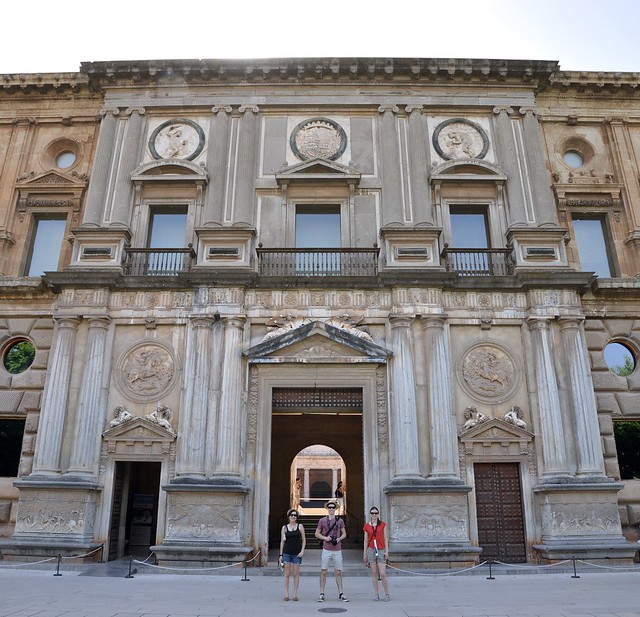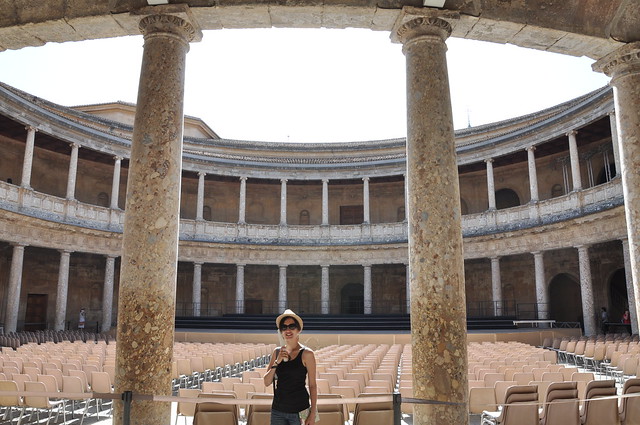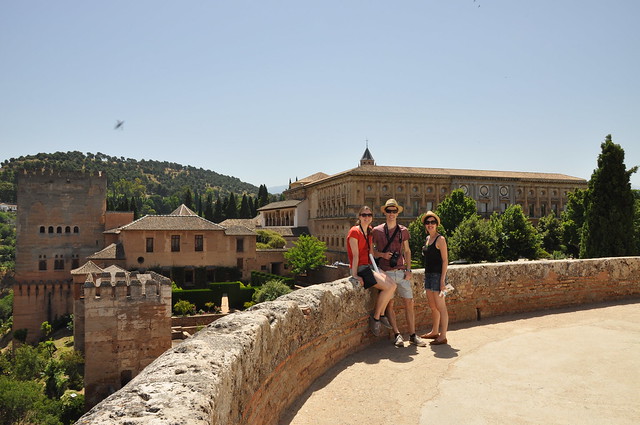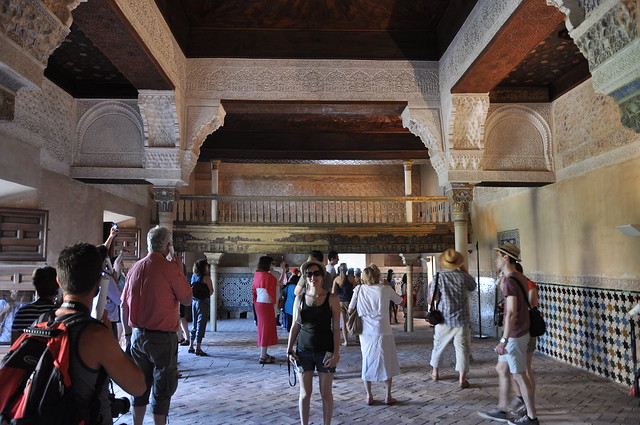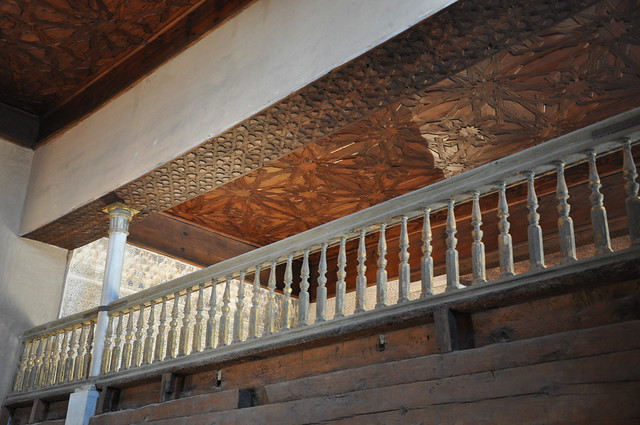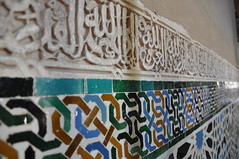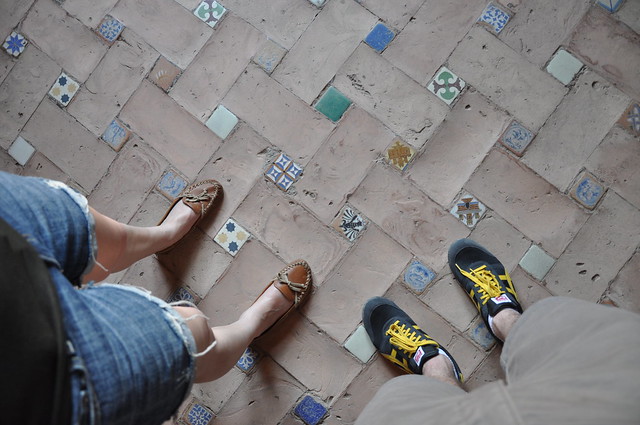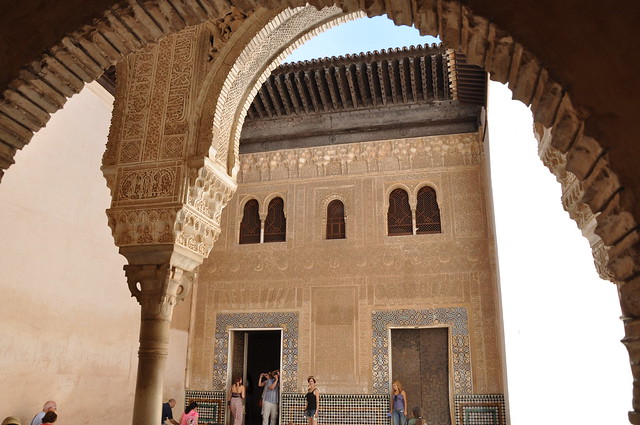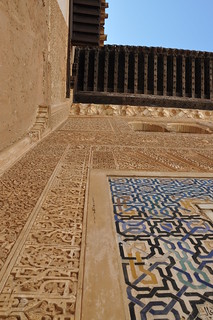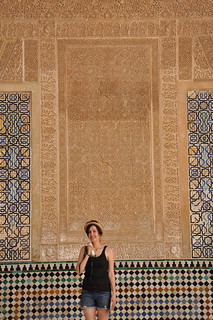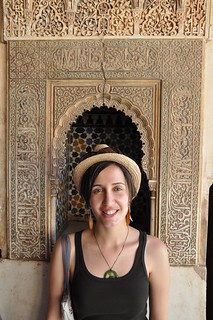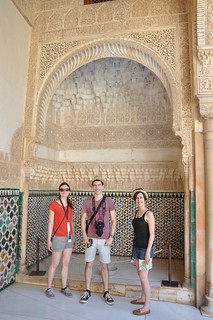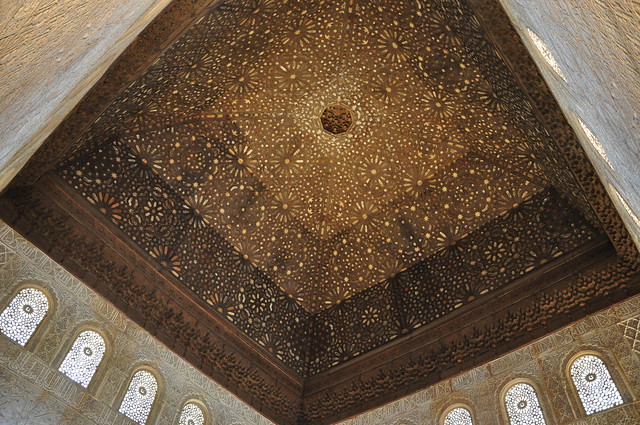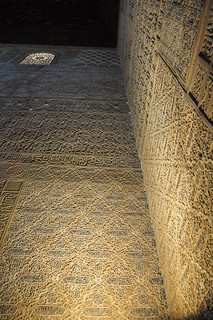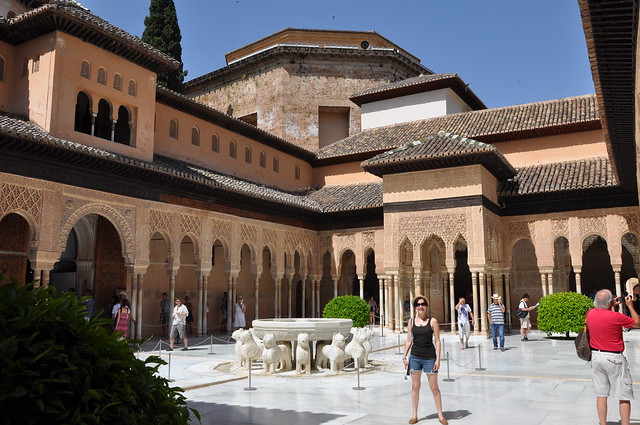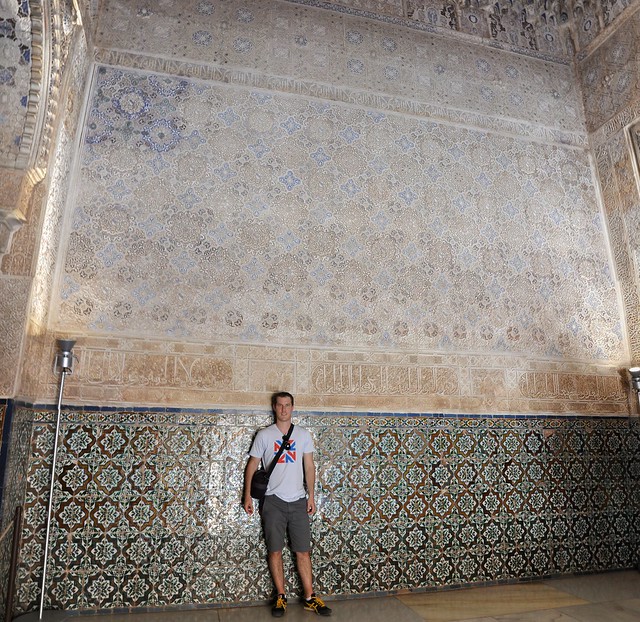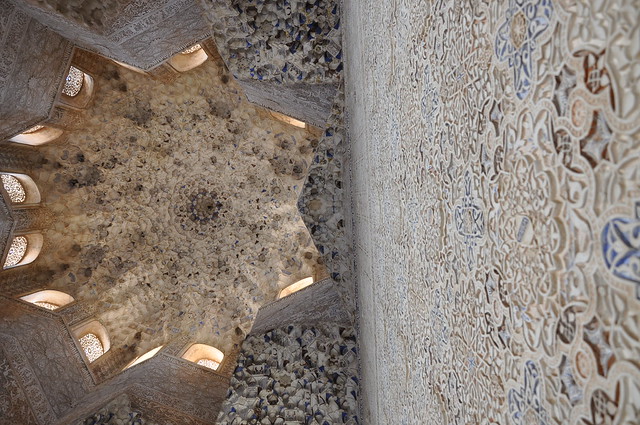Granada is a beautiful city with great food and an encouraging drinking culture, but the real reason to go to Granada is to see Alhambra – a fortress and palace complex, initially constructed in 889AD and converted into a palace in 1333. This was the first Islamic palace we had visited and we were impressed! Let me show you why.
First, its a huge fortress on top of a hill which Granada is built around.
To get up there, first you have to walk up the hill through the grand Gate of the Pomegranates, a 15th century triumphal arch at the bottom of a steep hill. We started at 8am so it was still relatively cool (only 21 degrees).
For me, European palaces often mean beautiful gardens, and Islamic palaces are no different.
One of the first sites while wandering around the huge complex was the Tower of the Seven Floors. The tradition says that Boabdil, the last Nasrid king, came out through this gate to give the keys of the Alhambra to the Catholic Monarchs in 1492. The tower was built in the 15th century after the gate because on top of the lintel of both gates the same sentence can be read: «Only God is Victor». An Islamic phrase.
Alhambra had all the services and resources it needed to be self sufficient. It even had its own public bath house used for daily washing. It was a series of little tiled rooms, each with inset baths of different temperatures. I love the starry ceilings!
The first palace we visited was one of the newest ones – Palace of Charles V. The Holy Roman Emperor ordered the construction of the palace next to the Alhambra in order to enjoy its wonders. The Renaissance styled works started in 1527 and were totally finished in 1957.
Its circular patio is unique and it is the most important building of Renaissance style in Spain. Very surprising!
Here we’re overlooking the Palace of Charles V on the right, but also the buildings containing the the old Islamic palaces on the left. We’ll get to those later.
The oldest part of Alhambra is the Alcazaba (pronounced Alcathaba) – the fortress. The first historical reference to the existence of the Alcazaba dates from the 9th century. The Alcazaba is surrounded a complex series of walls and towers and was used as the royal residence here before there were any palaces. Once the palaces were finished, the Alcazaba was only used as a fortress for military purposes.
The fortress is really a small city, with an urban distribution similar to that of any district of a Hispanic-Muslim city. You can see a little road separating the little shops and homes.
At the top of the Arms Tower is a great view of the fortress and Granada.
Granada looks amazing from up here – there’s the Cathedral in the middle. Stunning view!
But then we get to the good bit. The highlight of Alhambra are the Nasrid Palaces. There are three independent areas in the Nasrid Palaces. Firstly, there’s the Mexuar, which corresponds to the semipublic part of the palace for justice administration and State affairs. This would’ve been from the 10th century, but has had many modifications and renovations over the centuries.
The ceilings, floors, and trim are made of dark wood and are in sharp contrast to white, plaster walls. I loved all the tiles around the lower half of the walls! Beautiful!
The second area of the Nasrid Palaces was the Comares Palace, which was the official residence of the king. It has a couple of different areas, like the Gilded Room and the Portico of the Gilded Room. The Gilded Room is so called because of the painted Mudejar style of its coffered ceiling. The room was packed with people so too hard to photograph.
More impressive than the Gilded Room ceiling is the Patio attached to it. This small patio between the Mexuar and the Gilded Room connects both palaces. The tiling around the doors were beautiful and the again we were in awe about the details of the decorated plaster. So so detailed all the way up the wall!
Then, onto the largest space of the Comares Palace – the Court of the Myrtles. Its current name is due to the myrtle bushes that surround the central pond and the bright green colour of which contrasts with the white marble of the patio. It was also called the Patio of the Pondor the Reservoir because of the central pond, which is 34 metres long and 7.10 meters wide. There would’ve been residences in all the areas surrounding this pond.
At the southern end of the pond was the most majestic hall of the palace – Hall of the Ambassadors. This is where the throne was and where official receptions took place. It was a very impressive space – the wooden faceted ceiling was 18.20 meters high. The hall is completely covered by decorative inscriptions: niches, arches, walls and dressing rooms are all covered by poems. These are all praises to God or the emir, the Nasrid’s motto or texts from the Koran. Very cool! And so detailed!
The third and final section of the Nasrid palaces is the Palace of the Lions – a private area of the palace, where the Harem was located. The Patio of the Lions is beautiful and light. It’s called this because of the twelve lions that throw jets of water and which are part of the fountain in the middle of the patio. The big dodecagon-shaped basin rests on top of these twelve lions that are around it. This white marble fountain is one of the most important examples of Muslim sculpture.
The water tinkles and trickles echoing around the space, refreshing and beautiful but also so decadent considering the dry and arid part of the country we were in.
The patio is surrounded by a series of rooms, like this one – the Hall of Abencerrajes. It’s called that because apparently the Abencerrajes knights were beheaded here. The hall’s central square has bedchambers on its sides, with arches beautifully decorated, blue capitals and painted ceilings. The roof is decorated in blue, brown, red and gold, and the columns supporting it spring out into the arch form in a remarkably beautiful manner. Stunning!
Alhambra was so amazing. We’d never seen Islamic palaces or fortresses before, so it was amazing to see such beautiful examples.
If you’re ever going to the south of Spain, Granada is a must.
We’ve got some more stories from Spain to go!
Until then…


